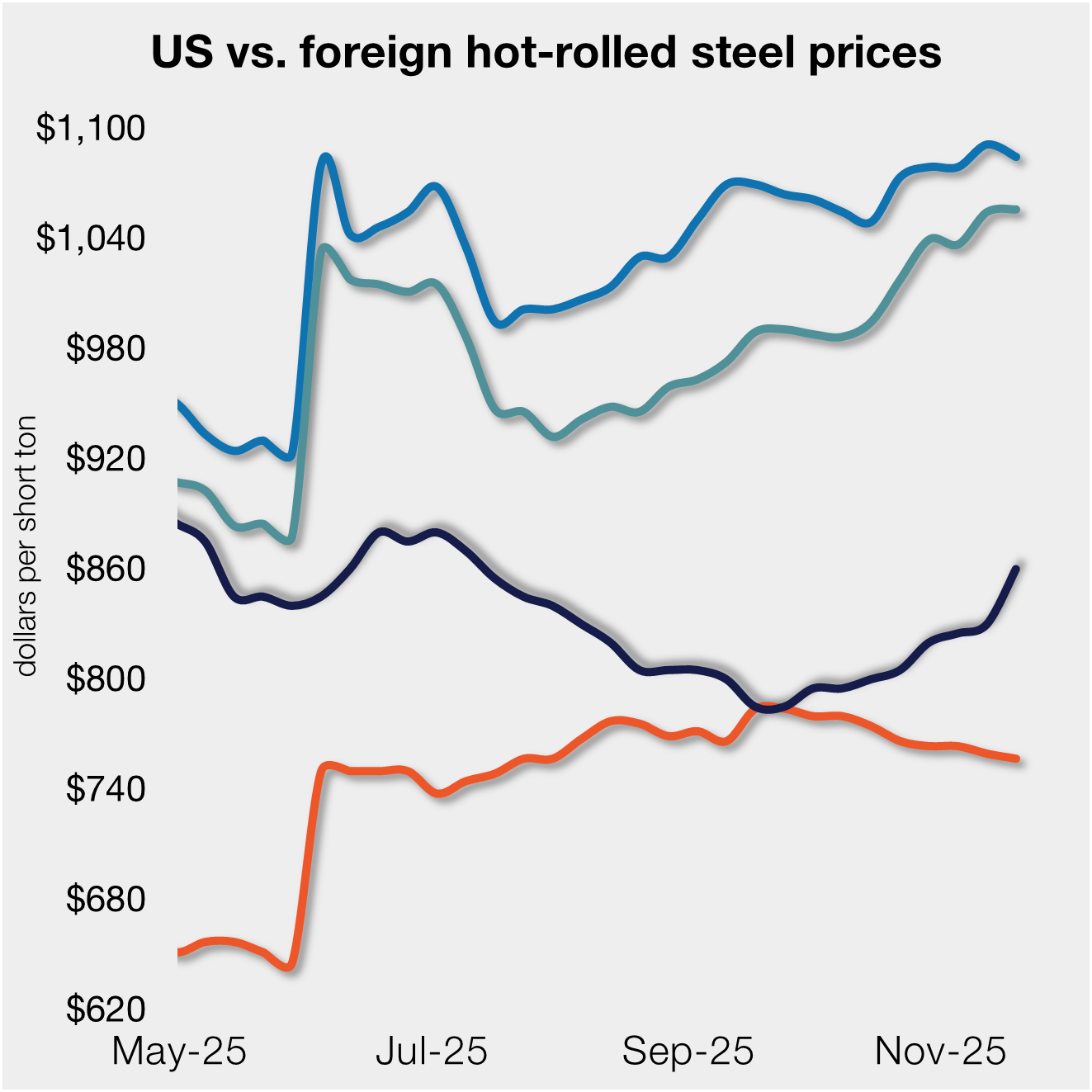Prices

March 12, 2022
CRU: LME Nickel Volatility and the Repercussions
Written by Greg Wittbecker
By Greg Wittbecker, Advisor, CRU Group
We digress from the woes of aluminum supply this week to comment on the LME nickel market, which has redefined volatility with a capital “V.” LME nickel has exploded due to a massive Chinese speculative position amidst Russian uncertainty.
Nickel fundamentals have been tightening for some time. In 2020, at the depth of pandemic, the world balance in nickel had a surplus of 117,000 tons. 2021 saw a sharp rebound pushing us into deficit of 171,000 tons, and we entered 2022 with the view that the market would turn off a slight surplus of 40,000 tons. Then came the Ukraine War.
Russia, in the form of Norilsk, is Europe’s largest producer of refined nickel at 145,000 tons/year. They rank on par with China (145,000) and Canada (127,000), but all are dwarfed by Indonesia, which produces 1.8 million tons/year predominately in the form of nickel/pig iron concentrates (NPI).
Norilsk supplies only 5% of global refined nickel, but has a disproportionate share of the European market. In this respect, it closely mimics the influence of the Russian aluminum giant Rusal, which supplies 40% of its production to Europe.
Uncertainty over the gravity of economic sanctions on Russia and its effect on Norilsk’s nickel exports caused LME nickel to spin out of control on March 8.
On Monday, March 7, nickel was trading on the LME at $48,000/ton. By the close of March 8, it had gone over $100,000 per ton and trading was suspended and remains so.
Large Commercial Short Positions Became Untenable
Beyond the supply side concerns, the LME price action was skewed by the large short position of a large Chinese commercial participant, who had amassed a short position of between 100,000 and 300,000 tons. To put that into context, a short position of that size would have represented between 3-10% of annual global consumption. It also would represent about 1.25 to 3.75 times the available stock (~80,000 metric tons) that the LME held at the end of February.
This large speculative holding was known to the Exchange, as it collects and reports the outstanding positions of commercial long and shorts. In fact, since early 2020, the net commercial shorts in the LME have ranged from 600,000 tons to a low of 400,000 tons. The LME also publishes a Banding Report that shows the concentration of the overall positions in percentages.
These reports did not set off alarm bells, as the market may have assumed (incorrectly in hindsight) that the short positions represented normal hedging transactions by producers of refined nickel and NPI.
One of my favorite sayings is that “all commodity markets operate on fear and greed.” Monday and Tuesday’s price action on LME nickel certainly brought out the fear factor and greed at the same time, as the longs appear to be taking aim at squeezing the shorts.
The magnitude of the price movement forced the LME to suspend trade to assess how to arbitrate margin calls on the shorts.
Margin Call 101 and the LME Decision to Void Trades of March 8
The LME allows its dealers to extend credit to its counterparts for their trading activities. All positions on the LME are “marked to market” at the close of each trading day. A difference account keeps track of the value of the commercial participant’s outstanding positions relative to the closing value. This difference account then compares it to the credit line for the client. If there is an outstanding loss greater than the credit line, it triggers a margin call.
Here is a simple example using the LME nickel experience between March 7 and March 8:
• March 7—Commercial player SELLS 1,000 tons of nickel at $48,000/ton and the market closes at that price. He/she has no gain/loss on the trade. The credit line is $10,000,000 and is untouched.
• March 8—Commercial player HOLDS short of 1,000 tons and market closes at $100,000/ton. He/she has an unrealized loss of $50,000,000 (1,000 tons x marked to market loss of $50,000/ton). The credit line of $10,000,000 is exceeded by $40,000,000 and represents the margin call.
Based upon the total shorts in nickel (550,000 tons) and the magnitude of the price movement on March 8, the margin calls for that one day would have been $27.5 billion on paper.
The LME has taken action to cancel all trades executed after midnight on March 8, arguing that “the market did not reflect the underlying physical market and that the nickel market had become disorderly.”
Why? A pragmatic answer would be that the likelihood of seeing those margins calls made basis $100,000/ton were “slim to none.”
What’s the Fallout?
Those of us who have long memories would compare this fiasco in nickel to the collapse of the LME tin contract in 1986. Cynics might be tempted to ask, “Why are you dredging up ancient history?” The reason is that because of the Tin Crisis, the LME underwent structural changes to create a clearinghouse mechanism and daily position reporting that would flag unusual concentrations of positions. Both measures were designed to mitigate dominant longs or dominate shorts from distorting orderly price action.
Clearly, something failed in nickel this week, as some participants aggressively drove prices much higher on March 8, seemingly seeking to financially wreck the shorts.
Many questions will now be raised asking whether the LME should have arbitrarily capped prices based on March 7 valuations, effecting relieving the shorts of the financial consequences of their large shorts.
It also remains to be seen whether the true clearing price of nickel will remain at or near $48,000 or will begin to rise again.
This volatility and intervention by the LME shakes confidence in the integrity of the nickel contract. This has a knock-on effect for those commercial buyers and sellers seeking to use the contract as a legitimate risk management tool.
For producers of nickel, can the contract be trusted to place short hedges and not be subject to predatory longs trying to squeeze them. For consumers of nickel, such as producers of 304 stainless, can the contract be trusted to place long hedges if the LME is going to arbitrarily cap their financial hedge profits.
For OEMs seeking to make material choices, 304 stainless steel doesn’t feel so right given this kind of volatility. If you are an aluminum rolling mill producing bright sheet for the white goods market, you like your chance against stainless. While aluminum prices are also volatile, they don’t compare to the fireworks in nickel this week. That $50,000 daily movement in nickel translates to a change in 304 alloy nickel cost of $8,000 per ton! That is volatility with a capital V and sends buyers back to the drawing board considering brushed or anodized aluminum.
CRU covers the nickel market comprehensively. Please contact Nikhil Shan (Nikhil.shah@crugroup.com) or Eoin Dinsmore (Eoin.dinsmore@crugroup.com) to explore CRU’s nickel coverage.
Greg Wittbecker joined CRU in January 2018 after retiring from Alcoa, where he was Vice President of Industry Analysis and Managing Director of Alcoa Beijing Trading, based in Shanghai, China. His career spans 35 years in the aluminum industry, having also held senior commercial and management roles at Cargill, Wise Metals and Koch Supply and Trading. Greg brings perspective on the entire aluminum supply chain from bauxite to aluminum finished products and will be a regular contributor to SMU going forward. He can be reached at gregory.wittbecker@crugroup.com
Request more information about this topic.
Learn more about CRU’s services at www.crugroup.com





